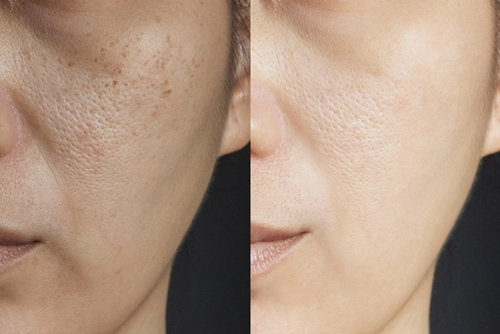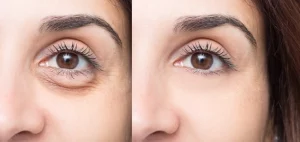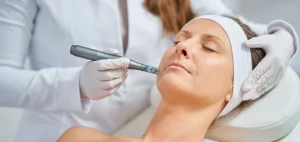Acne scars develop when breakouts damage the deeper layers of the skin. As the skin heals, it may produce too little or uneven collagen, leaving behind pitted, indented, or uneven marks such as ice pick, rolling, or boxcar scars. For many patients, these scars are not just cosmetic; they can impact confidence and serve as a lingering reminder of past breakouts. Treating acne scars effectively requires more than surface-level care; it calls for therapies that stimulate the skin’s natural repair process at a deeper level.
Microneedling, often referred to as collagen induction therapy, is one of the most effective non-surgical treatments for acne scars. The procedure uses ultra-fine, sterile needles to create controlled micro-injuries in the skin, triggering the body’s natural healing response. This stimulates the production of collagen and elastin, the essential proteins that repair damaged tissue and smooth out uneven texture. Over a series of sessions, microneedling softens scar tissue, plumps indented areas, and gradually reduces the visibility of scars, leading to clearer, healthier-looking skin. Unlike aggressive laser treatments, microneedling is safe for most skin types, involves minimal downtime, and provides natural, progressive improvement.
Acne scars can be frustrating, not only affecting skin texture but also self-confidence. At Dr. Syra Aesthetics in Manhattan, New York City, patients turn to Dr. Hanif, a board-certified physician in aesthetic medicine and Medical Director of Dr. Syra Aesthetics & Longevity Institute, for advanced solutions that truly make a difference. With extensive experience in skin rejuvenation and non-surgical treatments, Dr. Hanif has become a trusted authority in procedures like microneedling, Botox, dermal fillers, and RF therapies. Her expertise allows her to use microneedling to effectively remodel scar tissue, stimulate collagen, and restore the skin’s natural glow. Known for her compassionate, patient-centered care, she takes time to carefully assess each individual and design a treatment plan that achieves natural-looking, long-lasting results.
What Is Microneedling Treatment for Acne Scars?
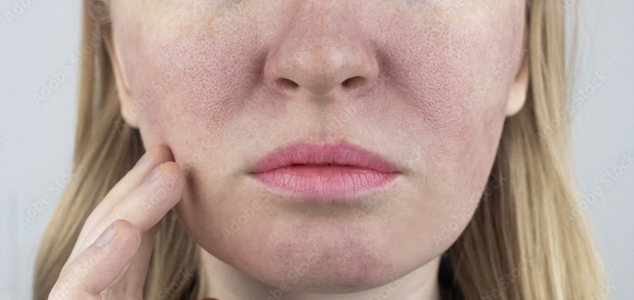
Microneedling treatment for acne scars is a safe, minimally invasive procedure that helps repair and remodel scarred skin by stimulating the body’s natural healing process. Acne scars often appear as pitted, uneven marks due to inflammation and collagen loss during the healing of acne breakouts. Microneedling addresses this by creating controlled micro-injuries in the skin using fine, sterile needles. These microchannels trigger the release of growth factors, activate fibroblasts, and boost collagen and elastin production. The result is smoother texture, plumper skin, and a noticeable reduction in scar depth and visibility.
What makes microneedling especially effective is that it works with the skin’s own biology. Unlike aggressive resurfacing treatments such as deep chemical peels or lasers, it carries minimal downtime, fewer pigmentation risks, and is suitable for a wide range of skin tones. Beyond scar reduction, patients often see benefits like refined pores, improved tone, and an overall youthful glow. Dr. Hanif recommends it as one of the most effective non-surgical treatments for acne scars and overall skin rejuvenation.
PRP Microneedling for Acne Scars
PRP Microneedling, also known as the “vampire facial”, enhances traditional microneedling by applying Platelet-Rich Plasma from the patient’s own blood directly into microchannels created during treatment. PRP is rich in growth factors, which accelerate healing, boost collagen production, and reduce inflammation. This treatment is particularly effective for moderate to severe scars (ice pick, rolling, boxcar) and offers faster recovery and stronger results. Because it uses the body’s own plasma, the risk of adverse reactions is minimal. Dr. Hanif recommends PRP microneedling for patients who want to not only smooth their scars but also enjoy brighter, healthier-looking skin in less time.
Microneedling for Acne Scars Procedure
During a typical microneedling session with Dr. Syra Hanif, the process is safe and comfortable. It follows three main phases: preparation, treatment, and aftercare, all carefully overseen by Dr. Hanif and her team to ensure the best possible outcome.
Before the session begins, Dr. Hanif evaluates the type and severity of acne scars and determines the most effective approach. Patients are usually advised to avoid retinoids, harsh products, or excessive sun exposure for a few days beforehand to prepare the skin.
On the day of treatment, the skin is gently cleansed and a numbing cream is applied to maintain comfort. Using a precise microneedling device equipped with ultra-fine, sterile needles, Dr. Hanif creates tiny, controlled micro-injuries across the treatment area. Depending on the patient’s needs, she may incorporate PRP to accelerate healing and boost collagen or RF energy to target deeper layers and tighten the skin. The procedure typically lasts 30 to 60 minutes, depending on the size of the treatment area.
After the session, patients receive detailed aftercare instructions to promote smooth healing and maximize results. With each treatment, collagen production increases, scars gradually fade, and overall skin texture improves, bringing patients closer to smoother, healthier-looking skin.
Different Types of Acne Scars Microneedling Can Treat
One of the most common questions Dr. Hanif is asked in our NYC clinic is about the different types of acne scars. Broadly, these scars fall into two main categories: atrophic scars and hypertrophic scars. Atrophic scars are the most common, appearing as sunken or indented marks when the skin doesn’t produce enough collagen during healing. These include boxcar, rolling, and ice pick scars, which microneedling effectively treats by stimulating new collagen to gradually smooth and even out the skin.
The second category is hypertrophic scars, which are less common but more challenging. Unlike atrophic scars, hypertrophic scars form when the body produces too much collagen during the acne healing process, leading to raised, thickened scars that can feel firm to the touch. These often remain within the boundary of the original acne lesion, and in some cases may resemble keloids, which extend beyond the initial spot. Because they are caused by excess collagen, hypertrophic scars don’t respond as well to traditional microneedling, but treatments can sometimes be tailored to soften their texture and reduce their prominence. During a consultation, Dr. Hanif carefully assesses whether your acne scars are atrophic, hypertrophic, or a combination of both. By identifying the type, she can recommend the most effective treatment plan whether that’s microneedling alone, or a combination of therapies to help you achieve smoother, healthier-looking skin.
Microneedling Before And After Acne Scars
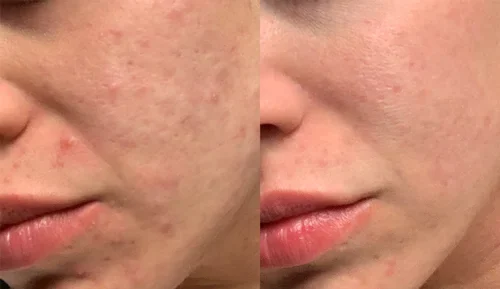
What to Expect After Microneedling (Downtime & Aftercare Tips)
Right after microneedling, your skin will usually look a little pink or red, almost like a mild sunburn, and it may feel slightly warm or tight. This reaction is completely normal and usually settles within 24–48 hours. Some people notice light flaking, dryness, or tiny pinpoint marks as the skin heals all signs that your body is starting its natural repair process.
Most patients are able to get back to their regular routines quickly, since the downtime is minimal compared to more aggressive treatments. Dr. Hanif often explains to patients that the first day is all about keeping the skin clean and calm. This means avoiding makeup, heavy sweating, or active skincare ingredients like retinoids and acids. Instead, stick to a gentle cleanser, a hydrating serum such as hyaluronic acid, and a fragrance-free moisturizer. And because the skin is more sensitive to the sun right after treatment, daily sunscreen is absolutely essential.
Over the following days, your skin will gradually feel smoother and more refreshed as collagen production kicks in. Redness fades, texture improves, and scars start to look softer. With each session, these changes build on one another, and with consistent aftercare, patients typically notice steady, long-lasting improvements in both acne scars and overall skin quality.
How Many Microneedling Sessions Do I Need To Get Rid Of Acne Scars?
The number of microneedling sessions needed to get rid of acne scars varies depending on the type and depth of scarring, but most people achieve the best results with about 3 to 6 sessions, usually spaced 4 to 6 weeks apart. Deeper scars may require additional treatments, or in some cases, advanced options like PRP or RF microneedling to maximize improvement. The encouraging part is that results build progressively with each session, so your skin continues to smooth out and scars fade more over time. Dr. Hanif will do a consultation with you to carefully assess your skin, discuss your goals, and design a customized treatment plan that ensures the safest and most effective outcome.
Microneedling for Acne Scars Cost in Manhattan, NYC
The cost of microneedling for acne scars in Manhattan is influenced by a variety of factors, including the specific type of microneedling performed (traditional, PRP, or RF), the size of the treatment area, and the geographical location of the clinic. Practices located in major cities such as New York typically have higher fees compared to suburban or smaller markets. The provider’s expertise also plays an important role — experienced specialists often charge more, while less experienced providers may offer lower rates.
Because most patients require multiple sessions to achieve the best results, package options may also affect overall pricing. At Dr. Syra Aesthetics in Manhattan, Dr. Hanif conducts a thorough aesthetics consultation to evaluate each patient’s skin, explain the most effective treatment plan, and provide a clear cost outline tailored to individual needs and goals.
Who Is a Good Candidate for Microneedling in NYC?
A good candidate for microneedling in NYC is someone in overall good health who wants to address acne scars, uneven skin texture, fine lines, enlarged pores, or mild skin laxity, and who isn’t experiencing active acne or skin infections. The treatment is considered safe for most skin types and tones, and a consultation helps confirm the right approach based on individual needs. At our NYC clinic, Dr. Syra Hanif meets with each patient personally to assess their skin and recommend the most effective microneedling plan, ensuring safe and natural-looking results.
Microneedling For Acne Scars Side Effects and Risks
| Side Effect | Risk |
| Redness & swelling | Common and temporary, usually resolves within 24–48 hours |
| Pinpoint bleeding / peeling | Normal healing response from micro-injuries |
| Pigmentation changes | Rare; temporary hyperpigmentation or hypopigmentation if aftercare is poor |
| Mild acne flare-ups | Possible if sebaceous glands are overstimulated or pores get clogged |
| Itching or skin tenderness | Localized inflammatory response during recovery |
| Infection | Rare; can occur if equipment isn’t sterile or aftercare is neglected |
| Worsening scars / keloids | Very rare; occurs in individuals prone to abnormal scar formation |
Does Microneedling Help Acne Scars?
Yes, microneedling helps improve acne scars by using tiny, sterile needles to create controlled micro-injuries that stimulate collagen and elastin production, allowing the skin to naturally repair and remodel scar tissue. It is especially effective for atrophic scars like ice pick, rolling, and boxcar scars, gradually softening indentations and smoothing skin texture over multiple sessions. Beyond scar reduction, patients also notice benefits such as refined pores, improved tone, and healthier-looking skin overall, making microneedling a safe and effective option for most skin types when performed by an experienced professional. At our NYC clinic, Dr. Hanif helps patients explore microneedling as a safe and effective way forward to achieve smoother, clearer skin.
What Is Microneedling Good For?
Microneedling is good for much more than acne scars. It helps improve skin texture, tone, and firmness by stimulating natural collagen and elastin production. Patients commonly choose it to reduce fine lines, wrinkles, large pores, sun damage, and stretch marks, alongside acne scars. Because it works with the skin’s healing process rather than resurfacing with heat or chemicals, microneedling is considered safe for most skin types and tones, making it a versatile solution for anyone looking to rejuvenate their skin without major downtime. Dr. Hanif recommends microneedling for patients who want visible results without aggressive procedures, since it not only restores smoother skin but also supports overall skin health in a gentle, effective way.
Which Is Better For Acne Scars, Traditional Microneedling vs RF Microneedling
Traditional microneedling uses fine needles to trigger the skin’s healing response, which works well for mild to moderate acne scars, pore size reduction, and surface texture. RF microneedling, on the other hand, delivers controlled heat energy deeper into the skin, making it more effective for tightening tissue and breaking down stubborn scar collagen. Dr. Hanif recommends starting with traditional microneedling for mild scarring, while RF microneedling is a better fit for patients with deeper rolling or boxcar scars, since it provides stronger collagen remodeling.
Which Is Better for Acne Scars, Chemical Peel vs Microneedling
When it comes to acne scars, the difference between chemical peels and microneedling lies in how deep each treatment works and the type of results they deliver. Chemical peels are effective for resurfacing the upper layers of the skin, helping to exfoliate, brighten pigmentation, and smooth mild surface irregularities. They work well for patients whose concerns are mostly about tone or mild textural changes, but they don’t reach deep enough to remodel scar tissue.
Microneedling, on the other hand, penetrates into the dermis, stimulating collagen and elastin production, which makes it far more effective for indented acne scars such as boxcar, rolling, or ice pick scars. In many cases, microneedling is considered the primary choice for treating acne scarring, while chemical peels may be used alongside it to address pigmentation issues and enhance overall results. At our NYC clinic, Dr. Hanif evaluates each patient’s skin during a consultation to recommend whether microneedling, chemical peels, or a combination of both would deliver the best outcome for smoother, healthier-looking skin.
Which Is Better for Acne Scars, Microneedling or Laser
Laser resurfacing and microneedling are both popular options, but they work differently. Lasers use heat energy to remove layers of damaged skin and stimulate regeneration, often producing fast results but with more downtime and a higher risk of pigmentation changes (especially in darker skin tones). Microneedling instead works by creating controlled micro-injuries, which remodel scars more gradually but with less downtime and broader skin-type safety. The best way to know which treatment is right for you is through a consultation with Dr. Hanif at our NYC clinic, where she carefully evaluates your skin and recommends the safest, most effective approach for lasting results.
Does Microneedling Get Rid of Acne Scars Permanently?
Microneedling offers long-lasting improvement by encouraging collagen remodeling, but it doesn’t always eliminate scars completely. Instead, it softens and reduces the depth of scars, making them far less visible. With the right number of sessions, results can be maintained for years, though occasional maintenance treatments may be recommended.
Can Microneedling Permanently Remove Acne Scars?
No treatment can guarantee the permanent removal of acne scars, but microneedling can make them significantly less noticeable. By stimulating new collagen, the treatment fills in depressions and smooths skin texture, producing results that are natural and long-lasting.
How Long Does It Take for Acne Scars to Fade?
While some improvement is visible within weeks of the first treatment, acne scars usually fade gradually over 3 to 6 sessions, spaced 4–6 weeks apart. Full results become more noticeable as collagen builds up over time, often continuing to improve for several months after the final session.
Is Microneedling Safe?
Yes, microneedling is generally safe when performed by a trained professional. The most common side effects are temporary redness, swelling, or mild peeling. Rare risks include infection or pigmentation changes, usually only if aftercare isn’t followed. Because it doesn’t use heat or harsh chemicals, it’s also safe for a wide range of skin tones.
Is Microneedling Safe for Pregnancy?
Microneedling is not recommended during pregnancy due to increased skin sensitivity, hormonal changes, and the body’s altered healing response. Dr. Hanif advises waiting until after pregnancy and breastfeeding before starting treatment.
What Are Some of the Different Treatments for Acne Scars?
Aside from microneedling, other options include laser resurfacing, chemical peels, dermal fillers, and RF treatments. The best choice depends on scar type, depth, and skin tone. In many cases, combining treatments yields the most effective results, with microneedling serving as a core option due to its versatility and safety. At our NYC clinic, Dr. Hanif offers personalized consultations to assess your skin and guide you toward the most effective treatment plan for achieving smoother, healthier-looking skin.
Dermal Fillers for Acne Scars
Acne scars often leave behind pitted or indented marks that make the skin look uneven. Dermal fillers can help reduce the appearance of these scars by adding volume beneath the skin, lifting depressed areas, and creating a smoother surface. They work especially well for rolling or boxcar scars where loss of tissue volume is most noticeable. While the results are not permanent, fillers can provide an immediate improvement that lasts several months to over a year, depending on the type of filler used. At our NYC clinic, Dr. Syra Hanif offers consultations to determine whether dermal fillers, microneedling, or a combination approach will give you the best outcome for softer, more even-looking skin.
How to get started with Microneedling for acne scars today?
Acne scars can be frustrating, leaving behind pitted marks, uneven texture, and reminders of breakouts that don’t fade with time. Many patients try creams or home remedies without seeing much improvement, which can feel discouraging. Scars often run deeper than the surface, and without the right treatment, they continue to affect both appearance and confidence.
At our NYC clinic, Dr. Hanif offers microneedling treatments that directly target these issues by stimulating collagen and elastin production to repair and remodel scar tissue. With her expertise in skin rejuvenation, she helps patients achieve smoother texture, softer scars, and healthier-looking skin over time. During your consultation, Dr. Hanif will assess your skin and create a personalized treatment plan—whether traditional microneedling, PRP, or RF microneedling that fits your unique needs and goals.

About The Author
Dr. Syra Hanif M.D.
Board Certified Primary Care Physician
Dr. Hanif is the Director of Aesthetic Medicine. She is a board-certified physician in Aesthetic Medicine who specializes in using non-surgical alternatives in order to enhance one's appearance through Botox and fillers.
Read More




